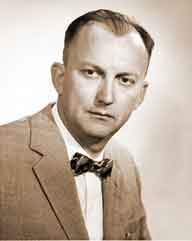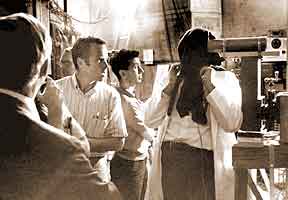|
Cornelius Tobias, a founding member of Berkeley Lab's
Donner Laboratory and a renowned pioneer in studying the
biological effects of cosmic rays and other ionizing radiation,
died of cancer on May 2. The man affectionately known
to his colleagues as "Toby" was 81.
 |

CORNELIUS "TOBY" TOBIAS
|
"Toby was an institution all by himself," said
Mina Bissell, head of Berkeley Lab's Life Sciences Division.
"He had many faithful followers and students and
was a charismatic leader and teacher."
Said long-time colleague Aloke Chatterjee, "Dr.
Tobias was a man of great vision and full of ideas. In
10 minutes he could easily come up with 11 ideas and,
astonishingly, most of them would work. His contributions
in fundamental radiobiology, space radiation biology and
cancer therapy with heavy ions have had major impacts
throughout the world. He was a great teacher, a great
leader and a great humanitarian."
Tobias' career at the Laboratory spanned more than 40
years. He started in 1942 and officially retired in 1987,
but continued to be active in research at the Lab for
the rest of the decade. In addition to his position with
the Laboratory, he was also a professor of medical physics
at UC Berkeley. Among the many honors he received during
his career was the 1963 E.O. Lawrence Award.
Born in Budapest, Tobias came to UC Berkeley in 1939
as a Hungarian-American Fellowship recipient after earning
his B.S. in physics at the Technical University in Budapest.
He obtained his Ph.D. in nuclear physics from Cal in 1942
under Lab legends Emilio Segrč and Luis Alvarez, and became
one of the first researchers to apply a physical sciences
background to the study of biology and medicine. That
was the year he teamed with John Lawrence to form Donner
Laboratory which, with its proximity to the 60-inch cyclotron
as a source of radioactive isotopes, became the birthplace
of nuclear medicine. He became a U.S. citizen in 1948.
With his knowledge of nuclear science and isotopes, Tobias
was a valuable member of the Donner group that began the
use of radioisotope tracers to study biomedical conditions
in humans.
The first of these tracers, carbon-11, was used to investigate,
among other phenomena, how pilots developed the "bends"
at high altitudes. Tobias also provided a mathematical
framework for the analysis of tracer turnover in the human
body which led to the discovery that inert xenon gas,
under sub-atmospheric pressures, can be an effective anesthetic.
Tobias was best-known for his radiobiology studies of
high linear energy transfer (LET) radiation, and in the
application of high LET radiation to cancer research and
therapy. Perhaps his most famous work started as a series
of experiments conducted in 1970 at the 184-Inch Cyclotron
to explain the mystery behind the peculiar flashes and
streaks of light reported by Edwin Aldrin and the other
Apollo-11 astronauts after their 1969 moon mission.
 |

CORNELIUS TOBIAS DONNED A BLACK HOOD TO KEEP OUT
THE LIGHT BEFORE EXPOSING HIS EYES TO A BEAM OF
FAST NEUTRONS IN A 1970 EXPERIMENT AT THE 184 INCH
CYCLOTRON. HELPING TO POSITION TOBY IN THE
BEAMLINE ARE JOHN LYMAN (LEFT) AND RALPH THOMAS.
|
Donning a special black hood, Tobias exposed his own
eyes to a variety of low-dose beams and saw the same display
of lights. A report by he and colleagues John Lyman and
Tom Budinger attributed the visual effects to helium ions
(alpha-particles) and high-energy neutrons colliding with
atoms in the eyes. They subsequently identified the source
of the lights witnessed by the astronauts as cosmic rays,
a phenomenon that Tobias had predicted nearly 20 years
earlier.
Tobias would continue these and other experiments in
space biology on the Bevatron which was capable of producing
artificial cosmic rays through the acceleration of nitrogen
ions to billions of electron volts of energy. He would
eventually help develop much of the technology required
to conduct biophysical experiments with particle beams,
and became a leader in the use of heavy ion beams for
the treatment of certain deadly cancers which could not
be treated through conventional surgery.
Said another long-time colleague and close friend, Eleanor
Blakely, "Professor Tobias' legacy is the large number
of individuals worldwide to whom he imparted scientific
curiosity for peaceful applications of radiation sciences.
He was a man of high integrity, and many will miss him."
Tobias is survived by his son, Martin, his daughter,
Eve Lippold, and two grandchildren, Julie Stier and Karen
Lippold. His wife of 55 years, Ida, died in 1998. A private
service was held for him in Eugene, Oregon on May 6. Those
wishing to make a donation in Tobias' name should contact
the Alzheimer's Association.
Additional information:
|


